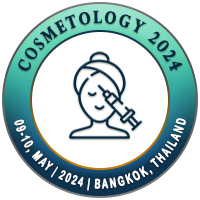
Asia Hafeez
Sir Syed College of Medical Sciences, PakistanTitle: Comparison of the efficacy and safety of 40% Glycolic acid & 60% Lactic acid chemical peel in treatment of epidermal melasma
Abstract
Title: Comparison of the Efficacy and Safety of 40% Glycolic acid & 60% Lactic acid Chemical Peel in treatment of Epidermal Melasma.
Background: Melasma is an acquired hyperpigmentary disorder characterized by the development of blotchy, light-to-dark brown macules distributed symmetrically on sun exposed parts of the body. It most commonly involves upper lips, cheeks and forehead, predominantly women with Fitzpatrick skin types IV to VI. Its etiology is multifactorial including oral contraceptives, pregnancy, racial, genetic, thyroid disease and sunlight exposure. Melasma is common dermatological problem in our part of world and it has psychological impact on patients. Glycolic acid peeling for melasma is being done as standard and effective treatment for melasma but it showed relapses and many side effects. Lactic acid is new agent introduced in treatment of melasma. Aim of comparison of chemical peeling with lactic acid to glycolic acid in epidermal melasma is to introduce and provide patient with a newer, safe and efficacious agent for chemical peeling in epidermal melasma.
Objective: To compare the efficacy and safety of chemical peel with 40% glycolic acid and 60% lactic acid in the treatment of epidermal melasma.
Method: In this comparative interventional study, 112 patients of 18 years to 40 years, suffering from epidermal melasma, not taking any treatment for melasma for last 4 weeks were included. Pre-treatment melasma area severity index (MASI) was calculated. 56 patients were treated with lactic acid peel and 56 with glycolic acid peel. Total of 6 sessions of each peel with 4 weeks interval were done and then monthly post treatment follow up for 2 months. During each visit MASI score was calculated. Photographs were taken at baseline and at follow-up visit. Percentage reduction of MASI was calculated at the end of therapy.
Results: In Group A, treated with 40% glycolic acid chemical peeling, efficacy of treatment was seen in 38(67.5%), while in Group B, treated with 60% lactic acid chemical peeling efficacy was seen in 45(80.4%). This proved that efficacy was higher in Group B but was not significantly different (P value=0.13) so final MASI reduced significantly in both study groups. Side effects e.g burning, erythema, scarring, crusting, post peel hypo/hyper pigmentation were 52(64.20%) in Group A and 29(35.80%) in Group B.
Conclusion: Both 40% Glycolic acid & 60% lactic acid chemical peeling agents are effective in treatment of epidermal melasma. 60% Lactic acid chemical peel is safer than 40% Glycolic acid chemical peel.
Key words: Epidermal Melasma, chemical peel, 40% Glycolic acid, 60% Lactic acid
Biography
TBA

